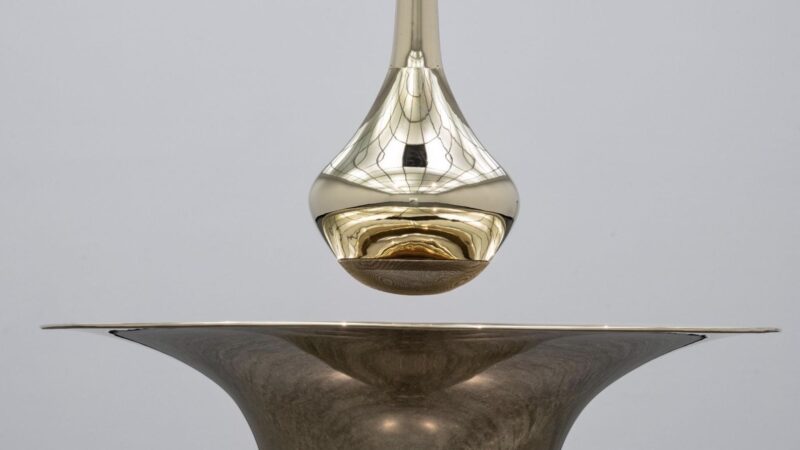Gyre begins with an invitation to pause: at the opening gallery is a thicket of recorded voices and three angular benches on which to sit and listen. When you do, you can feel the sounds tickling your thighs. Here, as throughout the latest exhibition of artist and musician Camille Norment’s work, the body is a source of unexpected capability, at once shaping and shaped by what we see and hear.
With Gyre, Norment headlines the 2023 Bergen International Festival (Festspillene i Bergen), Originally from Silver Spring, Maryland, and based in Oslo, Norway, Norment has been working for twenty years in visual art, sound, and performance. In a field that she has dubbed “cultural psychoacoustics,” her work traces the relationships between body, sound, and power, often through large-scale installations. Norment has a particular interest in instruments that exert palpable physical effects on the listener’s body, such as the water-powered glass armonica invented by Benjamin Franklin: a transparent cocoon made up of a horizontal stack of hand-blown bowls that was revered and reviled in its time for its supposed excitative properties. Norment can be heard performing on the glass armonica with the Camille Norment Trio, which includes an electric guitarist (Håvard Skaset) and a Hardanger fiddler (Vegar Vårdal). Before moving to Norway in 2005 with her partner, the Norwegian artist Knut Åsdam, Norment studied comparative literature, art history, and interactive telecommunications, in addition to working for a period as a researcher in Silicon Valley. In 2015, Norment represented Norway at the Venice Biennale, and, in 2020, she was named pro-rector of research at the performing- and visual art-focused Oslo National Academy of the Arts (Kunsthøgskolen i Oslo).
Gyre, a site-specific extension of Norment’s investigations into sound and space, is installed across the four resonant galleries of the Bergen Kunsthall. On display in one gallery is an earlier work, Untitled (Bellhorn) — a gleaming, bell-like brass shape, suspended above a tall basin of the same material, like a sort of a severe orchid — which had earlier been commissioned by and displayed at Dia Chelsea in New York City. Within the structure sits a hidden speaker, producing feedback in collusion with the four microphones aimed at the work from the ceiling, amplifying the vibrations of the room. The resulting sound is thick and magnetic, and onlookers at Gyre edged closer as though summoned; later, gallerists, perhaps fearing fingerprints, cordoned off the sculpture with a rope fence.
In another space, a giant iron coil sat quivering in the center of the room, accompanied by sounds of chattering teeth; along the walls were motile, abstract drawings made of iron, rainwater, pencil, ink, and blood. Everything But Noting, a drum stand affixed to the final gallery wall, included a outstretched bowl with two silver Chinese medicine balls that occasionally clacked against each other with the help of hidden magnets. Two girls approached the work, then jumped when the balls began to tremble. “Sorry!” they shouted, sprinting off. Their distended reflections flashed briefly in the nearby Frisson, a steel sphere emanating snippets of sonic models of the Big Bang.
In conjunction with the exhibition, Norment and her musical trio, joined by a team of Norway-based musicians, assembled one night for an ensemble performance at Håkonshallen, a historic stone 13th-century Viking banquet hall. At the center was Norment and her glass armonica, reflecting the ever-present summer sun churning out of the imperial window behind. She put her hands about the armonica, lightly at first, so that the sound was merely a squirm. Then, suddenly, came a pure beam of sound. Other musicians soon joined on the same pitch, adding pattering rhythms, while the singers in the round gestured outwards with cupped hands as if to capture the sound and hold it close. The hall thickened with new layers of timbre, reshuffling continuously to revive what had sunk beneath: percussive breathing from the brass players, or scuffling from the contrabass, or coordinated frenzies between smaller ensembles within the whole. Simmering continually beneath were tones from the glass armonica, like a flame barely kept at bay. A few listeners remained in the hall for some time after the performance, eyeing the instrument from a reverent distance as though waiting for it to sing.
— Jennifer Gersten for Guernica
Guernica: Feedback is a fundamental feature of many of your works. Can you recall what made feedback important for you early on?
Camille Norment: I listened to a lot of music that actively incorporated feedback growing up, such as Jimi Hendrix and Sonic Youth, and started to love the power and range of feedback — understanding it as an instrument, and how it’s coupled with so many different ways of producing music. Most people think of feedback as the relationship between a speaker and a microphone, but it’s also the environment in which that relationship happens. Alvin Lucier’s I Am Sitting in a Room is all about that. He creates a feedback loop over time by recording his voice and playing that back, then recording it again and again and again until his voice disappears and all you hear is the resonance of the room. What I really love about that work, besides the resonance and the feedback, is that he has a stutter. As his voice disappears, the rhythm of his stutter is still present in the resonant pattern and waves of the final result, so his body is very present in the abstraction. It points to this balance that I’m very interested in: sound for sound’s sake, but also sound’s relationship to specific bodies, places, and histories.
Guernica: What’s obvious from the moment you step into this exhibition is the sonic bleed between rooms. Did that bleed factor into your design of the exhibition?
Norment: Bergen Kunsthall is known for its acoustics — usually spoken about in negative terms. It’s an incredibly reverberant space, and it’s very difficult to hear somebody even when they’re standing next to you. It’s very wet and cavernous. But I also like that. I’m often looking for the opportunity to create some sort of site-specific connection. Since the rooms are interconnected with no doors, I knew right away that I wanted to create a work that would seemingly function as a single composition. That would happen anyway, whether I wanted it to or not. But making it a more conscious decision allowed me to think about what would travel the furthest — how to treat rhythm in terms of time, echo, and balance.
Guernica: The program notes liken the brass sculpture to a diagram of a black hole, which I thought was apt, given that the onlookers I observed drifted closer and closer to it. A New York Times review described one of your works as “hieratic,” and I sensed that, too — you feel worshipful as soon as you enter the gallery, and there’s this desire to make contact with the source of that feeling.
Norment: For me, all of these spaces are like temples, sonic temples. Words like “temple” and another word I might use, “spiritual,” fall very heavily, though I’m absolutely not talking about religion. But the work does create this space of intangibility, a space that should not have words. A space where sound is the meaning, sound is the experience, and all we can do is get kind of close in linguistic terms. What was also really important is thinking about each of these spaces as caverns or caves, like some of the early human caves found in the south of France, where they mapped and measured resonant frequencies. Many of these spaces have indications that they were used for gatherings, and they all have a very similar acoustic range. I think that’s very telling about the power of sound: it is produced and meets our surroundings, and it’s multiplied and then returned to us. That’s magic. It was wonderful to have those sounds remind me, and hopefully others, of the experience of walking through this early cave. Even though we’re walking through very clean and modernist and minimalistic rooms, this metaphysical awe and distance about something beyond words is still there.
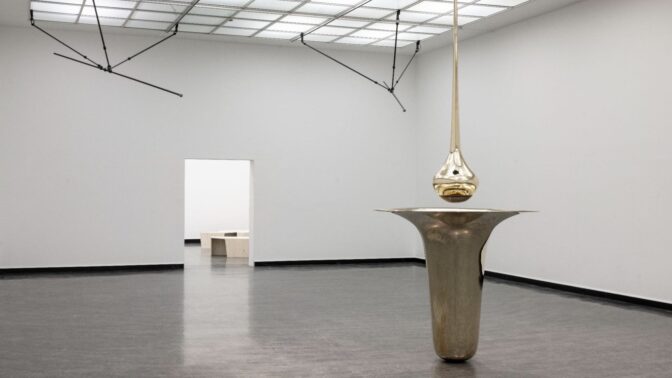
Guernica: How did you decide to make the loop the focal point of this exploration? On a more practical note, how did you go about making this golden centerpiece?
Norment: I knew I wanted to work with feedback, but that in itself wasn’t enough. So, when I finally got to go to the Dia space during the pandemic, I sat there, just listening and staring into the middle of the empty room, this beautiful industrial space with cement floor and brick walls. And then, suddenly, I saw a singing bowl in the middle. And it started to grow. Honestly, a lot of my work happens this way. If I need to compose something, I go somewhere where I can hear it. There are a lot of things that are already in our minds that our unconscious is constantly assembling for us, and it’s only a matter of finding a way to access it. Pioneers such as Pauline Oliveros taught us deep listening — how to listen to the outside, but also release what is already inside. The singing bowl turned into a bell and kept growing into this bell horn-flower, which also speaks to the organic nature of the work. It’s not a machine-generated object. I first tried to model it in plastelina and clay. The magic came, though, when real hands started to make it. On Zoom, I watched people clad in space suits pouring a bucket of molten metal that they had made specifically for this piece into a form. A fire even broke out, and they said, “Oh, don’t worry, this happens all the time.” It was amazing to see. It’s so hands-on and alchemical, which is also the part of the magic that goes into making these works.
Guernica: There are these physical tremors throughout the exhibition — in Coil, and also in Everything But Noting. I’m connecting this also to what I saw at the performance, in which you incorporated some dancelike motions. Could you speak to this interest in movement?
Norment: I composed hand gestures as an important part of the performance. Sound in the air was “captured” and released again; amplified whispers were spoken into cupped hands; syncopated snapping created a rhythmic base. It relates back to choreography, and the presence of the entire body in the creation of a sonic experience. I was trained in classical ballet and modern dance, and I performed in a dance company in Washington, DC. By high school, I knew I didn’t want a career in dance, but it was my first love, in a way. I think about choreography a lot when I’m conceiving of a new work. I don’t necessarily want to plan the movement so much as anticipate how it might be incorporated, how the work itself will move in relation to the bodies in the space. One of the works I made early on is Driftglass — a mirror in which you can’t see yourself. There’s a sensor that detects how close you are to the mirror and creates feedback. From about a meter and a half, if you get closer — and everybody gets closer, because, “Where am I?” — the feedback gets louder. So they push themselves back and they step to the side and try to come in from the side…
Guernica: I saw this online. It seems maddening.
Norment: It was amazing to watch, actually. I thought, “Wow, look at that dance!” Getting down below the mirror or peering in from the side created a space of choreography in which the viewers were trying from different angles to capture that image of themselves. It was just really wonderful. The desire to find a way to see yourself can be so strong, and my first thought was really just that the bodies that are being negated by the image of the mirror in which they do not appear but are affirmed by the sound, creating this feedback relationship between the mirror and the body. This was one of the pieces that made me think a lot more about choreography. Can I add an element that might encourage some kind of movement or interaction — but intuitively, without giving instructions?
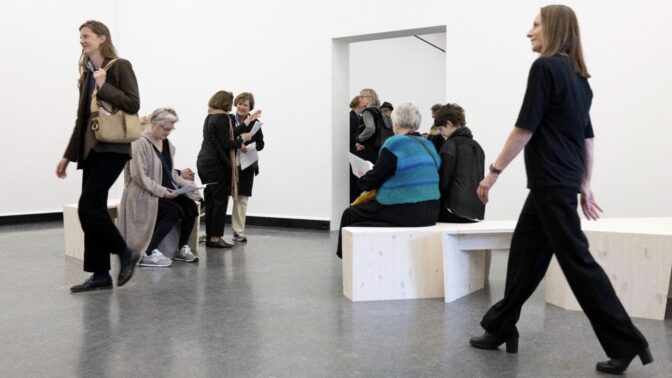
Guernica: I was also curious about how you view the relationship between your performances, as with the ensemble assembled for the performance at Håkonshallen, and your visual installations. In the past, you have also presented performances and installations in pairs. Would you even say that there’s a sort of feedback between the two forms?
Norment: Rather than seeing myself as a traveling musician, I like to consider a fluid movement in the spectrum around performance, composition, installation, et cetera. I was thinking about loops and the ring, and so I started composing a series of works for amphitheaters. Initially, for the Bergen performance, I was looking for a round space or theater that I could use for this piece, and there is a lovely space at the top of KODE [one of the Bergen art museums], but it was occupied. Which ended up being great, because I was so happy to work in Håkonshallen.
Guernica: You could just go in there and play scales, and it would be an event.
Norment: Yeah. It was such an amazing space. So I thought, Okay, we’ll construct the ring. I’ll have musicians and voices and audiences — this layering of bodies. That in itself created somewhat of a feedback spiral. I was also thinking, What are the relationships I can create between musicians across from each other? In the second half, the composition was aimed towards groups. We had the bass, cello, and viola as one set of gears, so to speak, and then the trombone, trumpet, and flute as another set of gears, all meant to be functioning in the same machine, but with different rhythmic patterns. Being in the performance center, I had a very different experience than the audience, but I think it worked well.
I wanted to think of the composition in terms of feedback loops as well. I started with a single noise, that whimpering little thing on the glass armonica that teases itself into this tone. And then we just meditate on that B for ten minutes. There’s so much life in that one tone. It’s amazing — I could play it all day. And then there was the feedback, which was fun because it’s very meditative to perform. I was negotiating my feedback signal EQ slightly to manipulate the sound. The listening grounds me immediately because I have to be so attentive to hear it and catch it before it becomes too big. It’s really like surfing. You have to catch the wave, but it’s a gentle catch — you don’t want it to get so out of hand that you have to let it out, but you want to awaken it and create conversations with it. It can be kind of tough work.
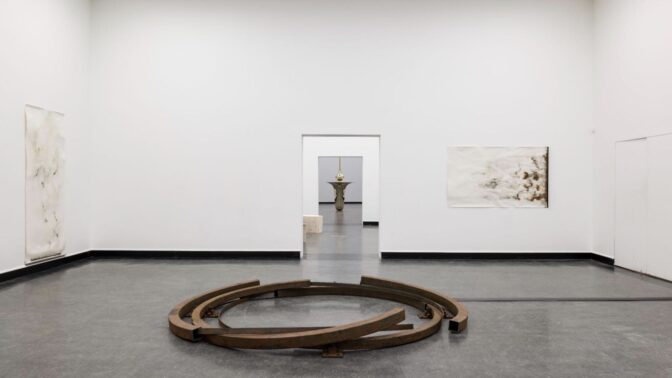
Guernica: I saw various broken shards near the glass aromonica after the performance, and I wanted to clarify: are those parts of the instrument that were broken while you were playing?
Norment: No. At one point, I brought the shards with me as another texture to play, and then they just became a good luck charm. I always travel with those specific shards of glass. I don’t even know where they came from — maybe it was a glass in my studio that broke years ago. They’re just a talisman. I’m happy to embrace my little rituals. I love the idea that people say “break a leg,” but you’re kind of redirecting the energy in a way, because you actually mean “good luck.” In my sort of logic, I’m directing the broken glass energy towards my performance.
Guernica: I was actually going to ask you about the presence of glass within your work.
Norment: Sometimes, when you start working with a material, it can stick for a while. It’s not that I thought, I want to work with glass, and I want to find a glass instrument. It was really a coincidence — almost too much. I joke, “Ugh, I’m going to be the glass armonica lady.” I would rather it be known that glass can be one aspect of what I do, but not the driving force.
I came to the glass armonica through the sound of rubbing your finger on the rim of a wine glass. The first piece that I created for the trio was after Arvo Pärt’s Fratres. It was one of the CDs that was always on rotation during the early-to-mid nineties. I hadn’t listened to it in a long time, but one day I was in Oslo listening to iTunes on shuffle, and up popped Fratres. Suddenly I heard it completely differently — as electric guitar, hardingfele [Hardanger fiddle, the Norwegian folk violin], and that high-pitched sound that was like rubbing your finger on the wine glass. I was like, The only way I can hear that again is if I make it. Then I thought, How do I find a guitarist and someone who plays hardingfele and explain this to them? By then, I hadn’t heard of the glass armonica. I thought, I’m going to have to play a box of wine glasses. So I was looking online for “box for wine glasses music,” or something, and then eventually I found this glass armonica thing. I thought, That’s an instrument? Really? And then reading about it — that it was invented by Benjamin Franklin, and Marie Antoinette wanted to play it, and Franz Mesmer? Its bizarre and even controversial history was a lovely entanglement of the power of sound and the body, and socio-cultural phenomena such as superstition, and psychology through “mesmerism.” I thought, This is an instrument for me.
One of the things I love about it is that it sounds so much like a sine wave, but it couldn’t be further away from a digital sine wave because each bowl is hand-blown. You look at them and they’re all a little bit wobbly and kind of wonky, and you can hear that imperfection in the sound. Every glass armonica is a little bit different; they will always have a slightly different kind of beat pattern across the same chord. It’s like a tour of history. In 1982, a German immigrant to the United States [Gerhard Finkenbeiner] was given contracts to make some crystal tubing for the production of chips. He had bits of crystal tube left over, and he’s like, What should I make with this? Oh, maybe that strange instrument I saw in Germany when I was a boy — the glass armonica? And so, after 200 years of being forgotten, the instrument was resurrected because of the digital world. I think that’s a lovely relationship.
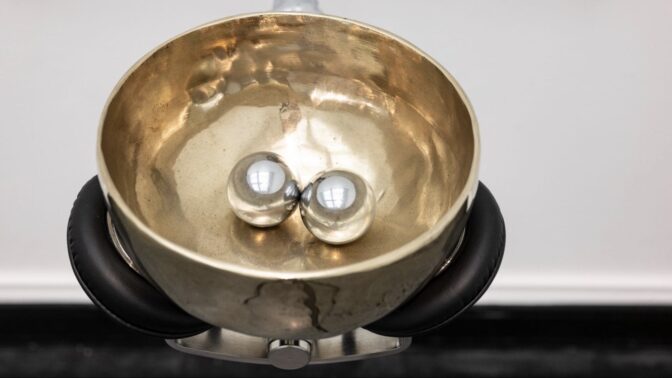
Guernica: How did you learn to play it?
Norment: I just bought it and hoped that it would work out. I play the piano, and the glass armonica is chromatic, so it was kind of intuitive. It’s made of crystal, which expands and contracts a lot. It will be slightly different in a warmer environment than in a colder one, just by microtones, but the overtones are also what makes it a nice abrasive combination with the hardingfele. I let it sit in the room overnight if I’m playing the next day so that it can settle into the temperature of that room. But then there are always different notes that don’t like whatever is going on that day — the temperature or the water or something. It’s almost as if the bowls have personalities; the G-sharp might have an attitude one day and require me to change my approach to it to get it to resonate.
Guernica: Do you feel that your visual and musical practices are ever in conflict? If so, how have you learned to manage?
Norment: There were a lot of things in conflict in my early days of being a practitioner. Am I an artist or a musician or an interaction designer, and how do I choose? It was really frustrating. At the time, even though it was emerging, the space for multidisciplinary practitioners didn’t really exist as it does today. That was a struggle for a while — feeling that I didn’t have a place, really, especially since a lot of the experimental sound community purposely wanted to have a disconnect from social and cultural contexts. That was really alienating, because I was interested in wanting those ideas to work together, because they already do, you know. So you just keep doing what you do and let other people put on the title. In different historical periods or perspectives, my project would be referred to as something different. But I don’t need to name it.

